OPOD - Algae Quételet colours
OPOD - Algae Quételet Colours: A Fascinating Display of Nature's Interference
Nature never ceases to amaze us with its captivating phenomena. One such mesmerizing spectacle is the "Quételet colours" that adorn the surface of still ponds, captivating observers with their subtle pastel hues. Named after Adolfe Quételet, a Flemish scientist from the 19th century, these colors are produced by the interference of light waves on reflecting surfaces. Although comparatively little known, they offer a captivating display for those who seek them out.
Discovering Quételet Colours
To witness the enchanting Quételet colours, one must seek out still ponds covered with algae or featuring a delicate film of pollen or dust. The presence of partial shading by trees often enhances the visibility of these colors on the sunlit surface. Additionally, dusty mirrors and windows can also reveal these hidden hues. It is in these quiet corners of nature that one can witness the magical interplay of light and particles.
Unraveling the Science
Unlike the colors produced by thin films, Quételet colours arise from small particles suspended just above the water or other reflecting surfaces. These individual particles scatter light waves through two distinct paths:
- Path 1: The particle scatters light, and some of the outgoing waves are reflected by the water surface.
- Path 2: Light is first reflected by the water surface and then scattered by the particle.
The waves from both paths interfere constructively and destructively. In certain directions, the wave crests from both routes align perfectly, resulting in brightness. Conversely, in directions where the waves are out of phase, darkness prevails. The visible outcome is a series of fringes that exhibit a range of colors when different wavelengths of white light interfere.
Exploring the Visual Delight
To truly appreciate the beauty of Quételet colours, it is helpful to visualize the fringes that they create. These fringes manifest as delicate bands of colors on the water's surface, forming intricate patterns and adding a touch of enchantment to the scene. The hues range from soft pinks and blues to subtle greens and purples, imbuing the surroundings with an ethereal ambiance.
Capturing Quételet Colours
Photographing Quételet colours can be a rewarding endeavor, allowing one to preserve these fleeting moments of natural artistry. To capture these colors in all their glory, it is essential to find the perfect vantage point that showcases the vibrant fringes. Experimenting with different angles and lighting conditions can reveal unique compositions and enhance the visual impact of the photograph.
Unveiling Nature's Hidden Gems
The Quételet colours offer us a glimpse into the intricate workings of nature's optical phenomena. By observing these subtle hues, we gain a deeper appreciation for the play of light and particles in our environment. As we delve into the wonders of atmospheric optics, we uncover hidden gems that remind us of the intricate and interconnected nature of our world.
Conclusion
The Quételet colours, named after Adolfe Quételet, are a captivating display of interference that grace the surfaces of still ponds. By understanding the science behind these colors, we can appreciate the complex interplay between light waves and particles. As we seek out these hidden hues in nature, we unveil a world of beauty that invites us to marvel at the wonders of our surroundings. So, next time you stumble upon a still pond or a dusty mirror, take a moment to admire the subtle pastel shades that adorn its surface and revel in the magic of Quételet colours.
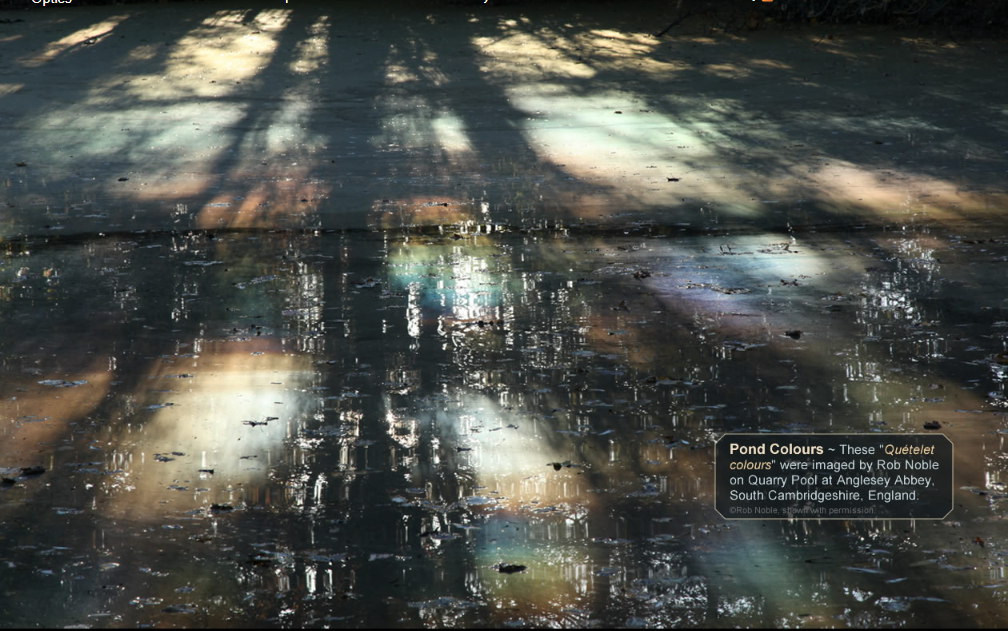
Pond Colours - These "Quételet colours" were imaged by Rob Noble on Quarry Pool at Anglesey Abbey. South Cambridgeshire, England. ORob Noble, stowwwth permission.
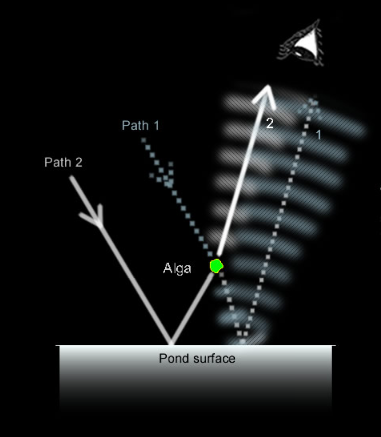
Waves on the dotted path (1) interfere with those on the solid path (2) making fringes and colours on the water surface.
Qu�telet colours (after Adolfe Qu�telet , Flemish scientist 1796 � 1874) are subtle pastel hues on reflecting surfaces.
They are comparatively little known.
Search for them on still ponds whose surface is covered with algae or has a film of pollen or dust. Partial shading by trees, as here, often helps to make the colours on the sunlit surface more evident. You might also find them on dusty mirrors and windows.
They are interference colours but not from thin films. They are instead produced by small particles just above a water or other reflecting surface.
Individual particles scatter light waves via two paths:
Path 1: Light is scattered first by the particle and some of the outgoing waves are reflected by the water surface
Path 2: Light is first reflected by the water surface and is then scattered by the particle.
Waves from routes 1 and 2 interfere constructively and destructively. In some directions wave crests from the two routes are in phase and there is then brightness. In directions where the two waves are out of phase there is darkness.
The visible result is a set of fringes. Different wavelengths of white light interfere in different directions and this colours the fringes.
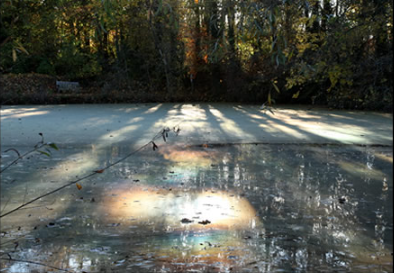
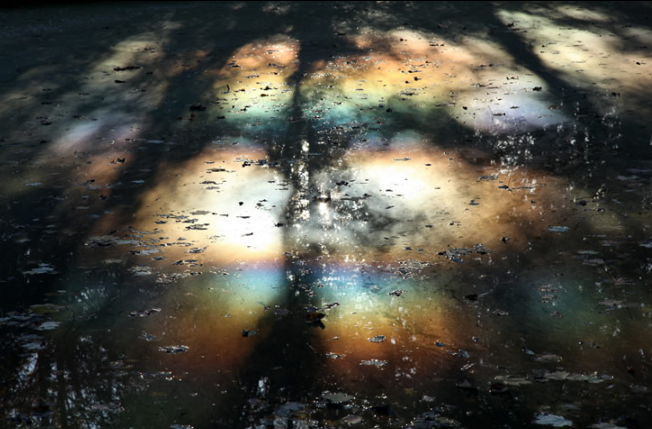
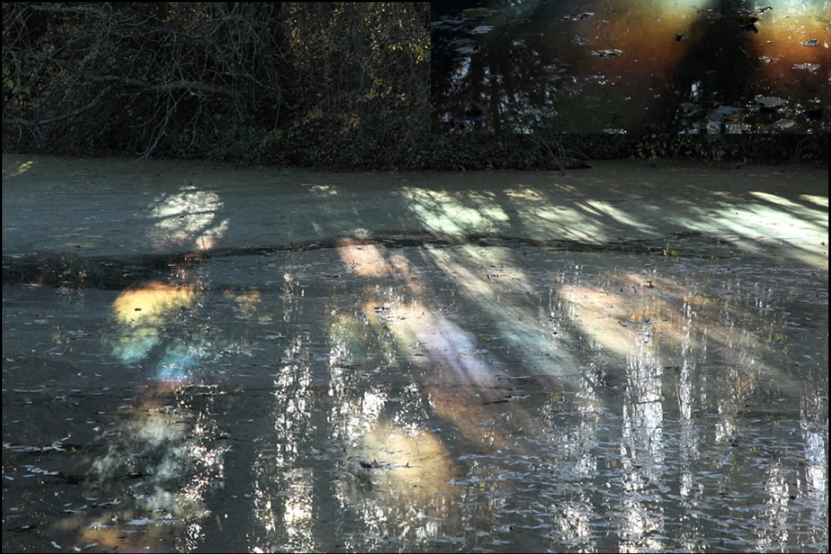
Note: this article has been automatically converted from the old site and may not appear as intended. You can find the original article here.
Reference Atmospheric Optics
If you use any of the definitions, information, or data presented on Atmospheric Optics, please copy the link or reference below to properly credit us as the reference source. Thank you!
-
<a href="https://atoptics.co.uk/blog/opod-algae-qu-telet-colours/">OPOD - Algae Quételet colours</a>
-
"OPOD - Algae Quételet colours". Atmospheric Optics. Accessed on November 26, 2024. https://atoptics.co.uk/blog/opod-algae-qu-telet-colours/.
-
"OPOD - Algae Quételet colours". Atmospheric Optics, https://atoptics.co.uk/blog/opod-algae-qu-telet-colours/. Accessed 26 November, 2024
-
OPOD - Algae Quételet colours. Atmospheric Optics. Retrieved from https://atoptics.co.uk/blog/opod-algae-qu-telet-colours/.